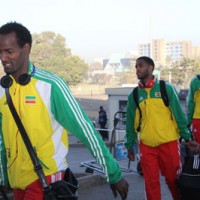Wednesday 30 January 2013
Tuesday 29 January 2013
Aida Desta
Aida Desta
Princess Aida Desta (1927 – 15 January 2013) was the daughter of Ras Desta Damtew and Princess Tenagnework, granddaughter of Emperor Haile Selassie of Ethiopia. She was the wife of Leul Ras Mangasha Seyum, Prince of Tigray, son of Seyum Mangasha, and great-grandson of Emperor ||Yohannes IV||.The young Princess accompanied her mother, siblings, and grandparents into exile in 1936 upon the occupation of Ethiopia by fascist Italy. Her father Ras Desta Damtew however led the resistance forces in southern Ethiopia for some months, until he was captured by the Italians and executed in 1937. Princess Aida and her sisters were educated at the Clarenden school in northern Wales, a favorite all girls school for upper class Britons and foriegn royals, and then went on to Cambridge. Princess Aida later returned to Ethiopia and married Ras Mangasha Seyum. They would go on to have five sons and a daughter. Princess Aida was active in charitable and cultural pursuits in Ethiopia during the reign of her grandfather Emperor Haile Selassie.
In 1974, Princess Aida was seized at the palace at Mekele by revolutionary soldiers sent to arrest her husband. Ras Mangasha had escaped days earlier and would establish the Ethiopian Democratic Union (EDU) which would fight the Derg regime until the EDU fractured in 1977 between rival factions. Princess Aida however had decided to remain behind and share the fate of her grandfather, her mother, and her family. Princess Aida was among the women of the Imperial family who were incarcerated under te Derg for 14 years. Her brother Prince Rear Admiral Iskinder Desta was executed along with 62 other former officials on Friday November 23, 1974. Together with her mother Princess Tenagnework Haile Selassie, and her sisters Princesses Seble, Sophia and Hirut, were Princess Sara Gizaw Duchess of Harrar (Widow of Prince Makonnen Haile Selasssie), Princess Yeshashework Yilma (the Emperor's neice by his elder brohter), Princess Ijigayehu Asfaw Wossen (daughter of the Crown Prince) and Princess Zuriashwork Gebre Igziabiher (widow of Prince Asrate Kassa). These women were made to share a former storage room in the precincts of the notorious Akaki Prison known as "Alem Bekagn" which translates to "I am down with the world". They shared matresses on the floor and were forced to endure the light of a single light bulp that was never turned off during their entire imprissonment. Years of campaining by their freinds and relatives as well as human rights and humanitarian organizations around the world had little effect in convincing the Derg regime to release the women of the Imperial family. The Princesses were suddenly and unexpectedly released from prison in September 1988, followed a year later by the men of the family.
After their release, Princess Aida resumed her interrupted family life with her husband and children in exile. She returned to Ethiopia after the fall of the Derg and split her time between the suburbs of Washington DC and Addis Ababa. She died on January 15, 2013 in northern Virginia.
Monday 28 January 2013
Africa’s best team so far
They are easily the best team that we have
seen so far at then Afco (Africa Cup Of Nations). They are mobile,
confident, skillful, organised and refreshing to watch. No I am not
talking about the usual big boys of Africa. I am talking about Ethiopia!
 Yesterday
Ethiopia took on defending champions Zambia and, for many, it was not a
question of who the victors would be (which many assumed would be
Zambia) but by how much they might win. End result 1-1. The victory went
to the Ethiopians in a moral sense.
Yesterday
Ethiopia took on defending champions Zambia and, for many, it was not a
question of who the victors would be (which many assumed would be
Zambia) but by how much they might win. End result 1-1. The victory went
to the Ethiopians in a moral sense.
As the game progressed it became clear that the Zambians were just as surprised as we all were at the quality of the Ethiopians. They are ranked as the least team in Africa by Caf and Fifa (31st in Africa). Parading a team of all home-based players they reminded me in so many ways of Barcelona of Spain. Yes they were that good!
Playing in a 1-4-5-1 formation with an extremely talented Said Saladin up front as the lone striker, they created goal scoring chances, ran rings around the Zambians with their passing game and put on constant pressure to prevent them from playing. They even the luxury to miss a penalty by Saladin.
They unfortunately had their goalkeeper sent off in the midpoint of the first half and played over an hour with one man less. The ‘Kung Fu kick’ by Ethiopia’s goalkeeper on the goal-bound Zambian deserved a red card.
However, here comes the interesting part. If you had missed the red card episode you would have thought that they were the team with one man more.
They kept on playing as if nothing happened.
Zambia eventually, against the run of play, took the lead via Mbesuma Collins, only to concede an equaliser minutes before the final whistle via Ethiopia’s Adane Grima.
Who says African coaches are not world class? The game plan, tactics and choreographed movements by the modest Ehiopian players are the brain work of their impressive coach, Sewnet Bishaw.
His astute decision to send in midfielder Addis Hintsa 25 minutes before the end of the encounter was key. He started the flowing move that led Adane Grima to the ball to score for Ethiopia.
Were they very good or were the Zambians just below par, or below what they had us used to last year? Well I feel it was a bit of both and slightly leaning to the fact that the Ethiopians were just better.
Their fans knew this before us all and were very vocal and present, to the delight of all neutrals.
Having said the above, I am curious to see how they confirm this five-star performance in the next group game v Burkina Faso. Confirm it or not they have made African football better and sent scares through their future opponents. Only time will tell us more.
by Sunday Oliseh
SuperSport.com

As the game progressed it became clear that the Zambians were just as surprised as we all were at the quality of the Ethiopians. They are ranked as the least team in Africa by Caf and Fifa (31st in Africa). Parading a team of all home-based players they reminded me in so many ways of Barcelona of Spain. Yes they were that good!
Playing in a 1-4-5-1 formation with an extremely talented Said Saladin up front as the lone striker, they created goal scoring chances, ran rings around the Zambians with their passing game and put on constant pressure to prevent them from playing. They even the luxury to miss a penalty by Saladin.
They unfortunately had their goalkeeper sent off in the midpoint of the first half and played over an hour with one man less. The ‘Kung Fu kick’ by Ethiopia’s goalkeeper on the goal-bound Zambian deserved a red card.
However, here comes the interesting part. If you had missed the red card episode you would have thought that they were the team with one man more.
They kept on playing as if nothing happened.
Zambia eventually, against the run of play, took the lead via Mbesuma Collins, only to concede an equaliser minutes before the final whistle via Ethiopia’s Adane Grima.
Who says African coaches are not world class? The game plan, tactics and choreographed movements by the modest Ehiopian players are the brain work of their impressive coach, Sewnet Bishaw.
His astute decision to send in midfielder Addis Hintsa 25 minutes before the end of the encounter was key. He started the flowing move that led Adane Grima to the ball to score for Ethiopia.
Were they very good or were the Zambians just below par, or below what they had us used to last year? Well I feel it was a bit of both and slightly leaning to the fact that the Ethiopians were just better.
Their fans knew this before us all and were very vocal and present, to the delight of all neutrals.
Having said the above, I am curious to see how they confirm this five-star performance in the next group game v Burkina Faso. Confirm it or not they have made African football better and sent scares through their future opponents. Only time will tell us more.
by Sunday Oliseh
SuperSport.com
Subscribe to:
Posts (Atom)








